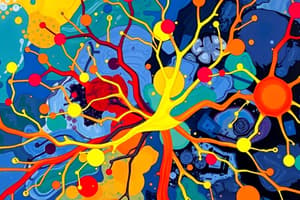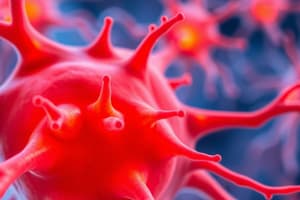Podcast
Questions and Answers
What is the name of the gap between the presynaptic neuron and the postsynaptic neuron?
What is the name of the gap between the presynaptic neuron and the postsynaptic neuron?
- Myelin sheath
- Synaptic cleft (correct)
- Axon terminal
- Node of Ranvier
What is the function of the myelin sheath?
What is the function of the myelin sheath?
- To produce neurotransmitters
- To generate action potentials
- To receive signals from other neurons
- To increase the speed of action potential propagation (correct)
What happens to the axon terminal when the action potential arrives?
What happens to the axon terminal when the action potential arrives?
- It becomes hyperpolarized
- It increases the thickness of the myelin sheath
- It releases neurotransmitters (correct)
- It generates a new action potential
What is the approximate width of the synaptic cleft?
What is the approximate width of the synaptic cleft?
Which of the following is NOT found in the axon terminal?
Which of the following is NOT found in the axon terminal?
Which of these is NOT a characteristic of ionotropic receptors?
Which of these is NOT a characteristic of ionotropic receptors?
Which type of receptor is typically involved in the transmission of sensory information, such as taste or smell?
Which type of receptor is typically involved in the transmission of sensory information, such as taste or smell?
Which neurotransmitter is commonly associated with inhibitory ionotropic synapses?
Which neurotransmitter is commonly associated with inhibitory ionotropic synapses?
What is the primary function of metabotropic receptors?
What is the primary function of metabotropic receptors?
What is one way that metabotropic receptors can influence cellular activity?
What is one way that metabotropic receptors can influence cellular activity?
What is the approximate size of a small vesicle containing neurotransmitters?
What is the approximate size of a small vesicle containing neurotransmitters?
Which of the following proteins is involved in the fusion of synaptic vesicles with the presynaptic membrane during neurotransmitter release?
Which of the following proteins is involved in the fusion of synaptic vesicles with the presynaptic membrane during neurotransmitter release?
What is the role of calcium ions in synaptic transmission?
What is the role of calcium ions in synaptic transmission?
Which of the following statements about synaptic vesicles is TRUE?
Which of the following statements about synaptic vesicles is TRUE?
What is the role of the postsynaptic density (PSD) in synaptic transmission?
What is the role of the postsynaptic density (PSD) in synaptic transmission?
Which of the following describes the process by which small molecule neurotransmitters are packaged into vesicles?
Which of the following describes the process by which small molecule neurotransmitters are packaged into vesicles?
What is the function of SNARE proteins in synaptic transmission?
What is the function of SNARE proteins in synaptic transmission?
What is the fate of synaptic vesicles that have released their neurotransmitter into the synaptic cleft?
What is the fate of synaptic vesicles that have released their neurotransmitter into the synaptic cleft?
What are the three main ways vesicles release neurotransmitters?
What are the three main ways vesicles release neurotransmitters?
In which of the following ways does a vesicle release a neurotransmitter, reseal, and then moves away from
the presynaptic membrane?
In which of the following ways does a vesicle release a neurotransmitter, reseal, and then moves away from the presynaptic membrane?
What is the difference between small-molecule neurotransmitter release and large-molecule neurotransmitter release?
What is the difference between small-molecule neurotransmitter release and large-molecule neurotransmitter release?
Which of the following statements about neurotransmitter release is TRUE?
Which of the following statements about neurotransmitter release is TRUE?
What is the role of the receptors in the synapse?
What is the role of the receptors in the synapse?
What is the name for receptors that open ion channels when bound by a neurotransmitter?
What is the name for receptors that open ion channels when bound by a neurotransmitter?
Which type of receptor uses a series of proteins to cause a cascade of effects within the cell?
Which type of receptor uses a series of proteins to cause a cascade of effects within the cell?
What is the key difference between ionotropic and metabotropic receptors?
What is the key difference between ionotropic and metabotropic receptors?
What is the role of the second messenger in the metabotropic signaling pathway?
What is the role of the second messenger in the metabotropic signaling pathway?
Which of the following is NOT a characteristic of neurotransmitters?
Which of the following is NOT a characteristic of neurotransmitters?
Which of the following methods of neurotransmitter removal is NOT directly involved in the rapid termination of synaptic transmission?
Which of the following methods of neurotransmitter removal is NOT directly involved in the rapid termination of synaptic transmission?
Which of the following is a characteristic of nondirected synapses?
Which of the following is a characteristic of nondirected synapses?
What is the main function of autoreceptors?
What is the main function of autoreceptors?
Which of the following accurately describes the mechanism of electrical synapses?
Which of the following accurately describes the mechanism of electrical synapses?
Which of the following is an example of a neurotransmitter that is typically removed from the synapse by enzymatic degradation?
Which of the following is an example of a neurotransmitter that is typically removed from the synapse by enzymatic degradation?
What is the primary function of glial cells in the removal of neurotransmitters from the synaptic cleft?
What is the primary function of glial cells in the removal of neurotransmitters from the synaptic cleft?
Which of the following is true about retrograde synapses?
Which of the following is true about retrograde synapses?
Which of the following best describes the role of electrical synapses in the nervous system?
Which of the following best describes the role of electrical synapses in the nervous system?
What is the effect of an excitatory postsynaptic potential (EPSP) on a neuron?
What is the effect of an excitatory postsynaptic potential (EPSP) on a neuron?
Which of the following is NOT a mechanism for removing neurotransmitters from the synaptic cleft?
Which of the following is NOT a mechanism for removing neurotransmitters from the synaptic cleft?
Which of the following is an example of an exogenous agonist for acetylcholine receptors?
Which of the following is an example of an exogenous agonist for acetylcholine receptors?
What is the primary effect of an inhibitory postsynaptic potential (IPSP) on the postsynaptic neuron?
What is the primary effect of an inhibitory postsynaptic potential (IPSP) on the postsynaptic neuron?
What is the role of receptors in synaptic transmission?
What is the role of receptors in synaptic transmission?
Which of the following is an example of a neurotransmitter that is degraded in the synaptic cleft?
Which of the following is an example of a neurotransmitter that is degraded in the synaptic cleft?
Which of the following is an example of how the number of receptors in a neuron can vary?
Which of the following is an example of how the number of receptors in a neuron can vary?
Which of the following statements about acetylcholine receptors is TRUE?
Which of the following statements about acetylcholine receptors is TRUE?
Flashcards
Action Potential
Action Potential
An electrical signal that travels along the axon, triggering synaptic transmission.
Axon Terminal
Axon Terminal
The end of the axon where neurotransmitters are released into the synapse.
Synaptic Cleft
Synaptic Cleft
The tiny gap (20-50nm wide) between two neurons where neurotransmitters cross.
Depolarization
Depolarization
Signup and view all the flashcards
Synaptic Transmission
Synaptic Transmission
Signup and view all the flashcards
Small vesicles
Small vesicles
Signup and view all the flashcards
Large dense-core vesicles
Large dense-core vesicles
Signup and view all the flashcards
Synapse
Synapse
Signup and view all the flashcards
Post synaptic density (PSD)
Post synaptic density (PSD)
Signup and view all the flashcards
Voltage-gated calcium channels
Voltage-gated calcium channels
Signup and view all the flashcards
Exocytosis
Exocytosis
Signup and view all the flashcards
Neurotransmitter release
Neurotransmitter release
Signup and view all the flashcards
Excitatory Post-Synaptic Potential (EPSP)
Excitatory Post-Synaptic Potential (EPSP)
Signup and view all the flashcards
Inhibitory Post-Synaptic Potential (IPSP)
Inhibitory Post-Synaptic Potential (IPSP)
Signup and view all the flashcards
Threshold Potential
Threshold Potential
Signup and view all the flashcards
Summation
Summation
Signup and view all the flashcards
Cholinergic Receptors
Cholinergic Receptors
Signup and view all the flashcards
Agonist
Agonist
Signup and view all the flashcards
Antagonist
Antagonist
Signup and view all the flashcards
Receptor Regulation
Receptor Regulation
Signup and view all the flashcards
Kiss and run
Kiss and run
Signup and view all the flashcards
Merge and recycle
Merge and recycle
Signup and view all the flashcards
Bulk endocytosis
Bulk endocytosis
Signup and view all the flashcards
Small-molecule transmitters
Small-molecule transmitters
Signup and view all the flashcards
Large-molecule transmitters
Large-molecule transmitters
Signup and view all the flashcards
Ligands
Ligands
Signup and view all the flashcards
Ionotropic receptors
Ionotropic receptors
Signup and view all the flashcards
Metabotropic receptors
Metabotropic receptors
Signup and view all the flashcards
Second messenger
Second messenger
Signup and view all the flashcards
Ligand-gated Ion Channels
Ligand-gated Ion Channels
Signup and view all the flashcards
Time to Onset of Effects
Time to Onset of Effects
Signup and view all the flashcards
Diffusion
Diffusion
Signup and view all the flashcards
Reuptake
Reuptake
Signup and view all the flashcards
Enzymatic Degradation
Enzymatic Degradation
Signup and view all the flashcards
Autoreceptors
Autoreceptors
Signup and view all the flashcards
Retrograde Synapses
Retrograde Synapses
Signup and view all the flashcards
Nondirected Synapses
Nondirected Synapses
Signup and view all the flashcards
Electrical Synapses
Electrical Synapses
Signup and view all the flashcards
Gap Junctions
Gap Junctions
Signup and view all the flashcards
Study Notes
Neurophysiology (part II): Synapses and Receptors
- Synapses are the connections between neurons, crucial for information transfer.
- Neurotransmitters are chemical messengers that facilitate communication across synapses.
- When an action potential reaches the axon terminal, depolarization occurs, triggering neurotransmitter release.
- Terminals house mitochondria, vesicles, and proteins.
- Small vesicles hold small molecule neurotransmitters, produced in the cytoplasm and packaged by the Golgi.
- Large dense-core vesicles contain peptides, synthesized in the soma and transported to the terminal.
- The synaptic cleft is a narrow gap (~20-50nm) between neurons.
- Synaptic transmission involves specialized proteins (SNAREs, synaptotagmin) for exocytosis (neurotransmitter release).
- Neurotransmitter release is fast due to the presence of readily available vesicles ("docked" or "release-ready").
- Different neurotransmitters have different fates: some are broken down (degradation), diffuse, or are reabsorbed (reuptake).
- Autoreceptors on the pre-synaptic membrane regulate neurotransmitter release.
- Retrograde synapses involve feedback from the postsynaptic side to the presynaptic neuron (e.g., nitric oxide).
- Non-directed synapses involve wider dispersal of neurotransmitters from varicosities (windows) on the axon.
- Electrical synapses (gap junctions) enable direct ion flow between neurons without chemical messengers, making communication extremely rapid.
- Neural circuits involve interconnected neurons and synapses.
- The knee-jerk reflex is an example of a simple neural circuit composed of sensory, and motor neurons.
- Visual systems exhibit convergence (multiple cells signal one) and divergence (one cell signals multiple).
- Number of receptors can change through up- or down-regulation.
- Different receptor subtypes (ionotropic and metabotropic) mediate various responses and have diverse durations.
Synaptic Transmission - Receptors
- Ligands fit receptors to activate or block them.
- Excitatory postsynaptic potential (EPSP) depolarizes the neuron, and inhibitory postsynaptic potential (IPSP) hyperpolarizes the neuron.
- Neurotransmitters bind to specific receptors.
- Receptors include ionotropic and metabotropic types.
- Ionotropic receptors are ligand-gated ion channels that cause quick, short-lasting effects.
- Metabotropic receptors are G-protein coupled receptors and cause longer, more complex effects.
- Neurotransmitters can cause the activation or deactivation of downstream chemical pathways, influencing the postsynaptic cell's long-term function.
- Synaptic activity can lead to the production of a threshold at the axon hillock.
- Different types of neuroreceptors that respond to neurotransmitters are excitatory or inhibitory.
- Ion flow creates EPSP or IPSP, and if the EPSP reaches a threshold, it leads to the generation of an action potential.
- Neurotransmitters are removed from the synaptic cleft or deactivated via enzymatic degradation and diffusion.
Studying That Suits You
Use AI to generate personalized quizzes and flashcards to suit your learning preferences.




